
Back to Loco of the Month homepage
Back to Sidestreet Bannerworks
.
October 2006
Archangel's Cyprus Gov't Ry. 2-6-0
by Marc Horovitz

This engine was built for the Cyprus Government Railway by Nasmyth Wilson in 1904. The 2' 6" gauge railway there was introduced by the British in 1905 and it lasted until 1951. The Turks invaded in 1974, dividing the island, and it remains so today. No. 21 had a sister engine (No. 22), built at the same time, and another (No. 23) assembled later from parts. These engines were built originally with round-top boilers, but were later converted to Belpaire fireboxes. Archangel's model is of the original design. Cyprus had several other small, attractive locomotives. Only one remains, an 0-6-0T, stuffed and mounted at Famagusta. (Thanks to Andrew Latham and Mike Simpson for the foregoing info.)
The model
This model is a pip! It was made late in Archangel's day in the sun, after Stewart Browne had moved to Wales from High Wycombe. I've been told that it was a one-off. I don't know exactly when it was made -- probably in the early to mid 1990s. Earlier engines often had the date of manufacture stamped on the frames somewhere, but this one does not. With no extant prototype to compare it to, I cannot comment on its fidelity. However, as a model locomotive, it has a lot to recommend it.
The engine has sprung first and third driven axles, while the second axle is rigid with the frames and has blind drivers (one driver is fully blind, while the other still has the vestiges of a flange). Side rods are articulated and nicely shaped. Valves are driven by full Walschaerts valve gear (have a look at the combination lever), with each of the components made by hand from steel plate. The valve gear is controlled by that most inconvenient of appliances, a screw reverser in the cab.
The dome lifts off to reveal the water-filler plug and the stack slides off for no known reason. A displacement lubricator resides on the deck in front of the smokebox, with a drain beneath, behind the leading wheel. The steam dome sports a Salter-style safety valve and a dummy whistle.
The backhead contains a throttle, a pressure gauge, and a water glass with a blowdown valve -- a nice feature. The gas tank rides under the roof, with access to the filler valve through a hole in the roof. A silicone hose connects the tank to the gas jet.
Sadly, the tender, though nicely made, is purely ornamental. It would have been nice if it carried at least the gas tank, to get the tank away from the heat of the boiler. The drawbar is simply a long screw that loosely connects the engine and tender, with a brass spacer between to prevent them getting too close to one another. Crude but effective.
The run
Run day was one of those glorious fall days that are a hallmark of Colorado. Temperatures were in the upper 70s and the sky was cloudless. I prepared the engine in the usual way, oiling all around and draining, then filling, the lubricator. I filled the boiler to near the top of the glass. But when I went to fill the gas tank, trouble reared its ugly head.
The gas valve would not close completely, so there was always a little gas weeping out. After a minute, the silicone tube popped off the jet. This was not good. A close examination revealed that the jet was blocked. To get at the jet, I had to remove the cab, which was not as easy as it first appeared to be. The jet holder was affixed to the floor with a single screw. I undid the screw and lifted the jet, realizing only then that it was integral with the burner.
The whole unit lifted out OK. I had hoped to unscrew the jet so that I could blow it out with compressed air. This was not to be -- it was soldered in place! I brought it to my compressor and, through the use of a rubber tube, managed to get some air through it. It was enough to clear the blockage.
With the engine reassembled and back on the track, I opened the gas valve and lit the fire at the smokestack. It flashed back immediately. Pressure came up in due course and I turned the gas down. I screwed the engine into gear and opened the throttle. The loco moved smoothly away with no starting hiccups. Splendid!
The rest of the run was as much as anyone could expect. It seemed a little lumpy at first, but I discovered that if I notched up the gear a little, the lumpiness smoothed right out. The engine bobbed over switches on its sprung axles and traversed the loop many times. The throttle was sensitive and the engine could be brought to a crawl with no trouble. The only problem was the gas valve, which wouldn't let me close the gas down to the point where the safety was not constantly blowing, thus wasting both gas and steam. However, that was a small price to pay, given the wonderful performance that this charming engine put on.

|
|
|
| Builder | Archangel Models |
| Date built | Early to mid 1990s |
| Gauge | 1 (45 mm) |
| Scale | 16mm |
| Boiler | Single-flue, internally fired |
| Fittings | Safety valve, throttle, pressure gauge, water glass with blowdown |
| Fuel | Butane |
| Blow-off pressure | 50 psi |
| Cylinders | Two, double-acting D-valve |
| Reversing gear | Walschaerts |
| Lubricator | Displacement |
| Weight | 7 pounds, 12 ounces |
| Dimensions | Length over end beams (loco and tender), 17-5/8"; width, 4-5/8"; height, 6-3/8" |
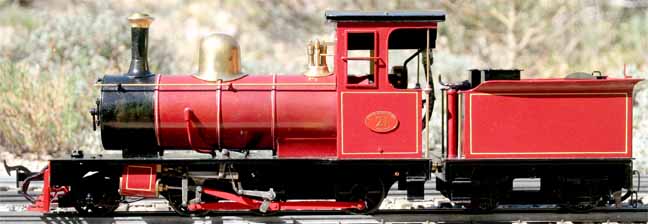
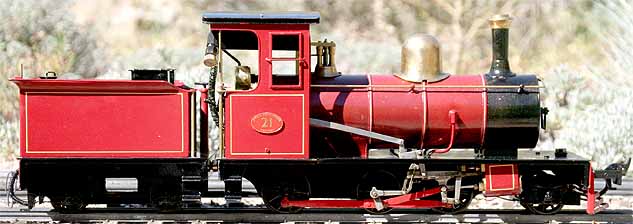

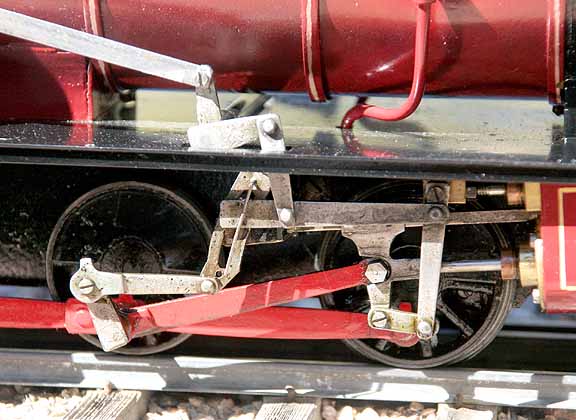

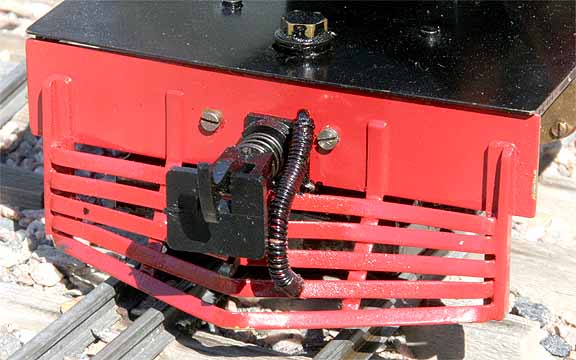

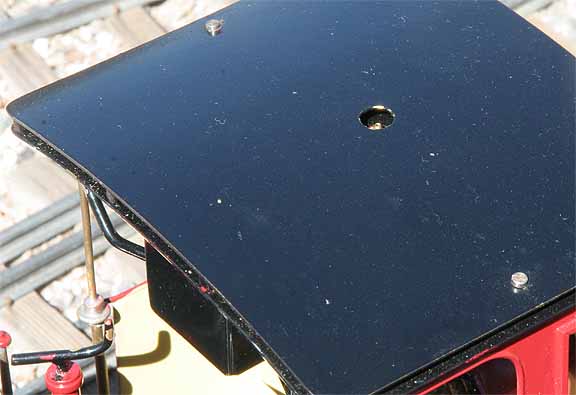
Above right: The gas tank, just visible below the roof on the left, is filled through the hole in the roof. Note the double roof, typical on tropical locomotives.
Right: The simple backhead. The gas line is that unsightly piece of silicone tubing. The tank would have done much better in the tender.
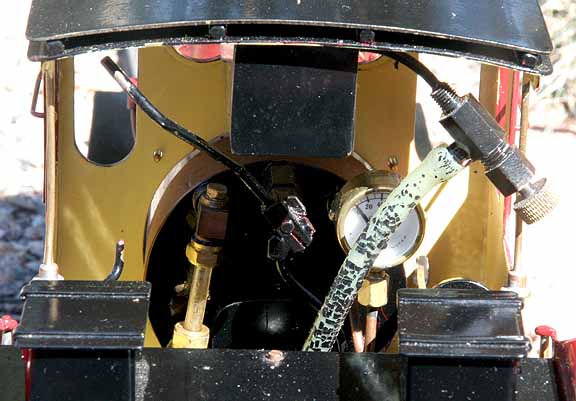
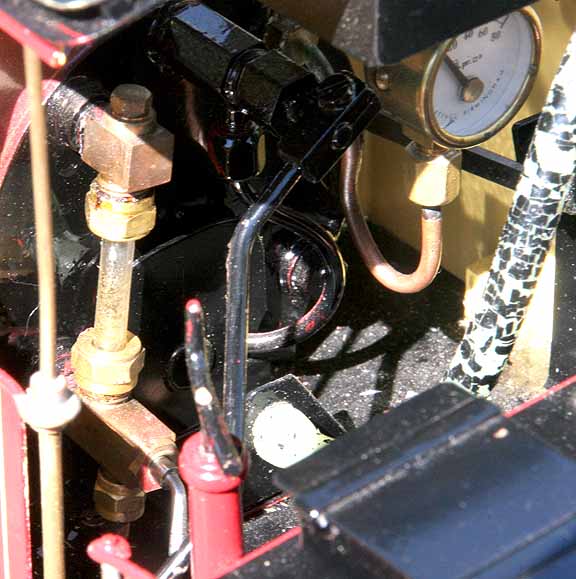
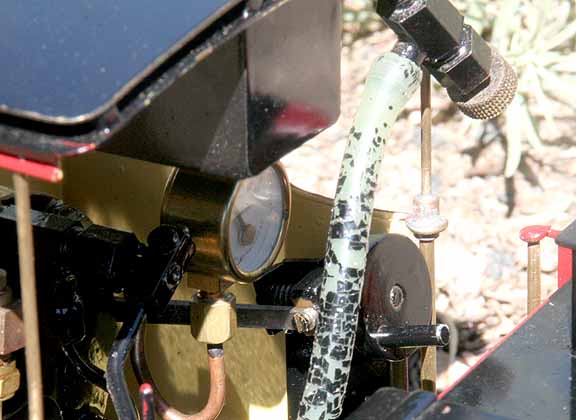

Back to Loco of the Month home page
Back to Sidestreet Bannerworks home page
This page and its contents
Copyright Sidestreet Bannerworks, 2006
.